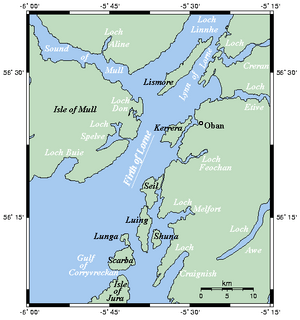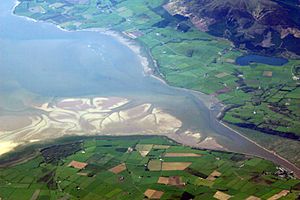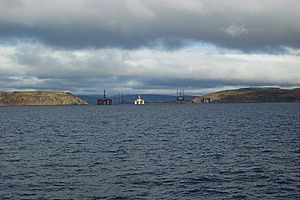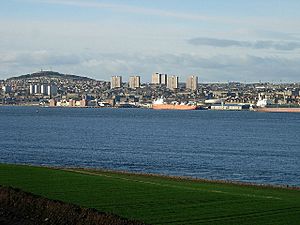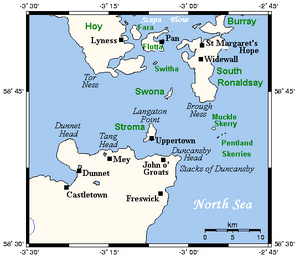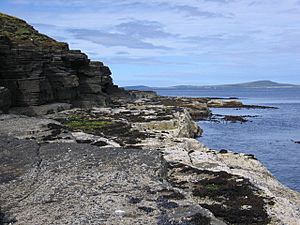Firth facts for kids
A firth is a special word used in English and Scots to describe different kinds of coastal waters in the United Kingdom, especially in Scotland. Think of it as a wide bay or a large arm of the sea that reaches inland. In the Northern Isles of Scotland, like Orkney and Shetland, a firth can also mean a smaller inlet of the sea.
The word "firth" is related to "fjord", which you might know from places like Norway. Both words come from an old language called Proto-Germanic. While fjords are usually long, narrow, and steep-sided inlets carved by glaciers, firths can be a bit different. They are often wider and more open.
Many firths were formed by glaciers during the Ice Age. They are often found where a large river meets the sea. The strong tides from the ocean push seawater up the river, making the riverbed wider and forming an estuary. Sometimes, it's hard to tell exactly where a river ends and a firth begins. For example, the Firth of Clyde starts where the River Clyde gets much wider near Port Glasgow.
While many firths are wide river mouths, some are different. The Cromarty Firth looks more like a large loch (a Scottish lake or sea inlet) with a narrow opening to the sea. The Solway Firth and Moray Firth are more like very large bays. The Pentland Firth is actually a strait, which is a narrow passage of water connecting two larger bodies of water, rather than a bay or inlet.
Contents
Exploring Scotland's Firths
Scotland has many famous firths, especially along its east and west coasts.
Firths on Scotland's West Coast
These firths are found along the rugged west coast of Scotland, facing the Atlantic Ocean.
Firth of Lorn
The Firth of Lorn is the northernmost firth on the west coast. It connects to the Moray Firth on the east coast through a series of lochs and canals, including the Caledonian Canal and Loch Ness.
- Places nearby: Oban, Fort William.
- Islands: Isle of Mull, Lismore, and Kerrera.
Firth of Clyde
The Firth of Clyde is a large and important firth that continues from the River Clyde estuary. It's a busy area with many towns and islands.
- Sea lochs joining the Firth: Gare Loch, Loch Long, Holy Loch, Loch Striven, Loch Riddon, Loch Fyne, and Campbeltown Loch.
- Places nearby: Helensburgh, Port Glasgow, Greenock, Gourock, Dunoon, Rothesay, Wemyss Bay, Largs, Brodick, Ardrossan, Troon, Ayr, Girvan, and Campbeltown.
- Islands: Bute, Cumbrae, Arran.
- In Scottish Gaelic, the Firth of Clyde is sometimes called Linne Chluaidh for the inner part and An Linne Ghlas for the outer part.
Solway Firth
The Solway Firth is a large inlet that forms part of the border between Scotland and England. Rivers like the Eden, Esk, and River Nith flow into it.
- Places nearby: Carlisle, England (on the River Eden), Annan, and Gretna (both in Scotland).
Firths on Scotland's East Coast
These firths are connected to, or form part of, the North Sea.
Dornoch Firth
The Dornoch Firth is the northernmost of the eastern firths.
Cromarty Firth
The Cromarty Firth is a loch-like firth with a narrow opening to the sea. It flows into the larger Moray Firth.
Moray Firth and Beauly Firth
The Moray Firth is a large triangular inlet. The Beauly Firth is a smaller, loch-like firth connected to it. The Moray Firth also connects to the Firth of Inverness (which is rarely named on modern maps) and then via the River Ness and Caledonian Canal to the west coast.
Firth of Tay
The Firth of Tay is the estuary of the River Tay, one of Scotland's longest rivers.
Firth of Forth
The Firth of Forth is the estuary of the River Forth. It is famous for its bridges.
- Places nearby: Edinburgh, Dunfermline, Kirkcaldy, Falkirk, Stirling, Grangemouth.
- Rivers: Forth, River Avon, Water of Leith, River Almond, River Esk, River Leven.
- Islands: Bass Rock, Inchcolm, Inchkeith, Isle of May.
- Bridges: The Forth Road Bridge and the historic Forth Bridge span this firth.
Firths on Scotland's North Coast
Pentland Firth
The Pentland Firth is a strait, not a bay or inlet. It lies between the Scottish mainland and the Orkney Islands, connecting the Atlantic Ocean and the North Sea. It is known for its strong currents.
- Places nearby: John o' Groats.
- Islands: Hoy, Pentland Skerries, Swona, South Ronaldsay, Stroma.
Firths in the Northern Isles
The Northern Isles (Orkney and Shetland) were once part of Norway, so many of their place names have Norse origins. In these islands, "firth" can refer to smaller inlets, similar to "geo," "voe," or "wick."
Orkney Islands
- Bay of Firth (Firth, Orkney)
- North Ronaldsay Firth
- Stronsay Firth
- Westray Firth
- Wide Firth
Shetland Islands
- Lax Firth (Laxfirth)
- Collafirth/Colla Firth
- Firths Voe, Firth
- Whale Firth
- Burrafirth
English Firths
The most well-known firth in England is the Solway Firth, which we already mentioned as it borders Scotland.
Firths Outside Britain
Sometimes, the word "firth" is used for similar bodies of water in other parts of the world, often in places with historical links to Britain.
- Flensburg Firth: An estuary that forms part of the border between Denmark and Germany.
- The Firth of Thames: A bay in New Zealand at the mouth of the Waihou River.
- Firth of Tay, Antarctica: Named after the original Firth of Tay in Scotland because it is near Dundee Island.
Images for kids
See also
In Spanish: Firth para niños


